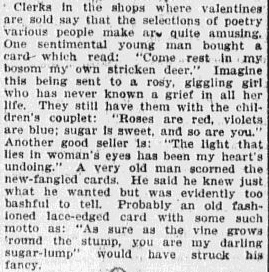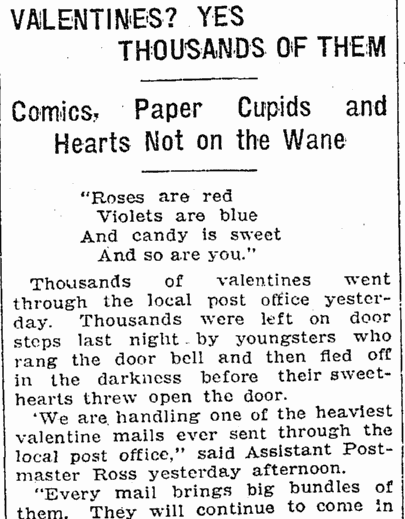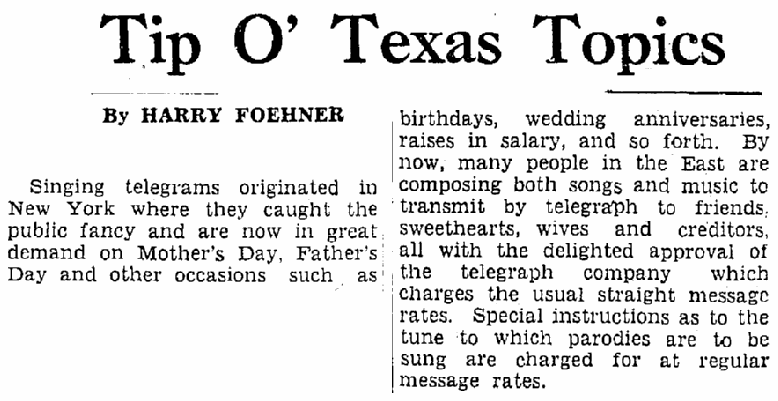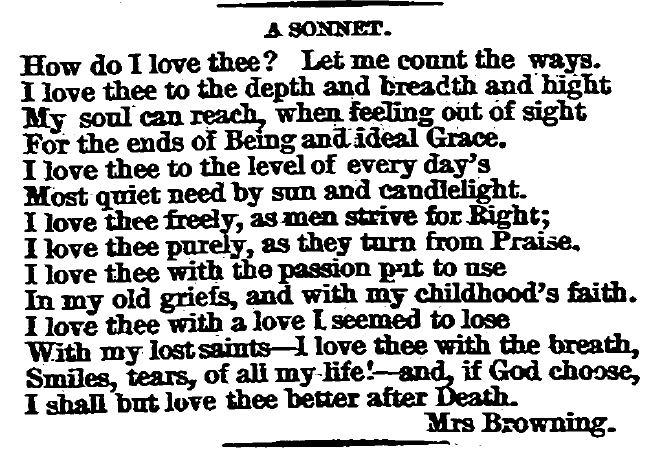Introduction: In this article, Mary Harrell-Sesniak searches through old newspapers to find valentine poems and other romantic messages from Valentine’s Day celebrations of the past. Mary is a genealogist, author and editor with a strong technology background.

http://www.loc.gov/pictures/item/2010645777/
Ask any child if they know a valentine poem, and they’re likely to recite this couplet:
Roses are red,
Violets are blue.
Sugar is sweet,
And so are you.
Love Poem History in Newspapers
If you research early newspapers, such as the online collection in GenealogyBank’s Historical Newspaper Archives, you’ll discover quaint “Roses are red” valentine traditions—along with many variations on the theme. Many of these old love poems have delighted children and amorous suitors for a very long time.
One of the earliest “Roses are red” newspaper references was in this 1874 review of Fantoccini, a book fashioned after a puppet show by the same name.

Roses Are Red Alice
The author of this newspaper article panned Fantoccini for mimicking the “Alice” books, and criticized this version of “Roses are red” as an example of how “any number of well-meaning idiots have been moved to think that they could do as well” as the Alice in Wonderland books.
Roses are red
Diddle, diddle,
Violets are blue;
You love not me,
Diddle, diddle,
Though I love you.
Could them three flowers
Diddle, diddle,
Alter their dyes,
Then might we love
Diddle, diddle,
Contrariwise.
Turn of the 19th Century Valentine’s Day Trends
An 1899 Valentine’s Day trend was to send a valentine with a small object attached. One such Valentine’s Day card had an artificial violet and featured this poem:
Roses are red, violets are blue;
Sugar is sweet and so are you.
So please accept this small bouquet
That I have picked for you today.

As cards became commercialized, shop clerks often assisted shoppers in their frantic searches for the perfect valentine card. These clerks were often amused at the suitors’ choices, as not everyone chose wisely!
In 1907, a sentimental young man purchased a valentine with this plea:
Come rest in my bosom my own stricken deer.
I hope his love interest fell for that line, although he might have been better off with this fashionable seller of the day:
The light that lies in woman’s eyes has been my heart’s undoing.
As this article notes, the old favorite was also offered on 1907 cards:
Roses are red,
Violets are blue;
Sugar is sweet,
And so are you.

Anonymous Valentine Admirers
Have you ever sent or received an anonymous Valentine’s Day card?
In 1909, valentines overwhelmed the mail carriers, but “cupids” were also prone to depositing a card at a young woman’s door, ringing the bell and then fleeing off into the darkness before being discovered.

Valentine Telegrams
There once were even valentine telegrams—certainly a relic of the past to any of today’s youth.
Western Union used to offer suggestions as to what to write. Many valentine poems and sayings reflected the era they were written in, such as these hipster valentine telegrams from 1954. These messages were always printed in upper case, as that was the only typeface option available for telegrams:
- “MY HEART’S A-FIRE. FOR YOU I PINE. SAY YES-YES-YES MY VALENTINE.”
- “ROSES ARE RED, VIOLETS ARE BLUE: THERE’S NO ONE ELSE BUT YOU-YOU-YOU.”
- “MAN, YOU’RE GROOVY, CHICK O’MINE: BE MY REAL COOL VALENTINE.”
- “LET IT RAIN. LET IT DRIZZLE. KISS ME, BABE, AND HEAR ME SIZZLE.”

Then of course there were singing telegrams that suitors could use to woo their valentines, which, according to this 1938 Texas newspaper article, originated in New York. Popular for multiple holidays, the telegraph company accommodated special requests—including special tunes and parodies.

Valentine Newspaper Advertisements
Was your family particularly romantic on Valentine’s Day? If so, see if they may have placed valentine advertisements in newspapers. Search your hometown papers, but remember to be creative, as the suitors rarely used their full names!

Romantic Ideas & Inspiration
If you’re feeling like “Roses are red, Violets are blue” doesn’t express the perfect sentiment for your sweetheart, you can always find inspiration by searching old newspapers for romantic poetry.

That reference to “Elizabeth Barrett” reminds me of one of my favorite love poems of all time: this timeless verse by Elizabeth Barrett Browning.

Happy Valentine’s Day everyone!
Explore over 330 years of newspapers and historical records in GenealogyBank. Discover your family story! Start a 7-Day Free Trial
